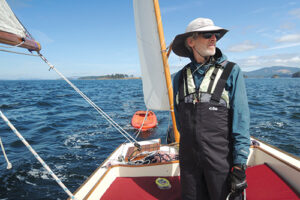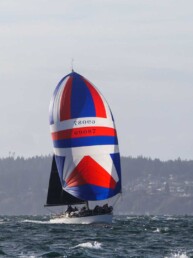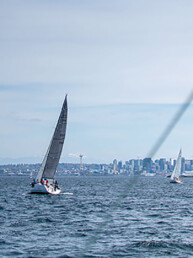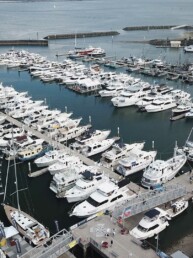
A heat wave had swept over the Pacific Northwest, but I wasn’t thinking about the temperature as Luna bucked and skidded over the knee-high chop during a crossing of Rosario Strait. Our 19-foot wooden catboat never faltered or showed signs of being tender on that July afternoon. But my senses were on high alert, as this was my wife Kate’s first open-water crossing in a small boat, not to mention it was also her first cruise.
Thankfully, each time I glanced across the cockpit, there was no greenish tinge to her face nor clenched white knuckles. Instead, she gazed expectantly across the water towards the San Juan Islands, a tentative smile on her face.
That lasted until we reached a place where I felt no need to fear, Thatcher Pass, the central entrance to the archipelago from the east. “Uh, Bruce, is that the ferry?” Kate asked. “Isn’t it getting kind of close?” I watched as the four-story ship emerged from behind the conifer-studded edge of Decatur Island.
“We’ll be fine, as long as we give way,” I said. “Also, remember, we’ve got a 175-square-foot white sail that the captain can easily see.”
This moment brought me back to our early discussions about how life together on the water might work. With our kids fully independent, we finally had the chance to do something new together. I’d been taking extended cruises in small boats for a dozen years, and now Kate was curious to see what it was all about.

Kate was always happier with a book than engaging in outdoor adventure. In deciding to come cruising, I knew she was venturing far from her comfort zone. Maybe, I suggested, she should take the woman-led sailing course offered by a local boating group?
I didn’t expect her to become an expert prior to our journey, but she’d feel safer and more confident aboard, I believed, if she knew the basics and what to do should there be a problem
“What if I just want to come sailing this one time,” she asked. “Not actually become a sailor?” I started to respond about being partners on the boat, like we were at home and while raising our kids. But then I paused. This was a perfectly reasonable question.
“Okay, sure,” I said. Maybe treating a spark of sailing curiosity with care and patience might kindle a fire.
“I mean, I want to know what to do if you get knocked out, or something,” Kate added. “But maybe everything else can wait.”
And so, on an unusually hot summer day, we found ourselves launching Luna at Cap Sante Marina in Anacortes. Kate had broken her wrist a few weeks earlier, but the cast on her arm didn’t deter her from nesting in the tiny cabin, hanging LED lights, arranging bedding, and organizing food, while I set up the rigging and threaded lines through the blocks. When we were both satisfied with the arrangements, we pulled away from the dock for a safety check in the placid waters beyond the breakwater.
“So, if there’s a real situation, the most important thing is to de-power the mainsail,” I explained, while Kate looked ruefully from her cast to the halyards, clearly wondering how she might handle this, literally singlehanded. “And watch out that the boom or gaff doesn’t knock you on the head.”
“And what about the radio?” she asked. After a few minutes of fiddling with the VHF’s buttons and self-consciously practicing how to make an emergency call, we both felt satisfied enough to embark on our two-week journey.
With the timing of tidal currents and wind as our primary means for deciding where and when to go, we explored around Lopez Island for a few days, but Kate and I really wanted to see the less-visited islands, accessible only by private vessel, so off we went. Even with a mild breeze, I could stand in a Zen state at the tiller for hours, but during these slow passages, Kate preferred to retreat into the shade with a book and emerge when there was something new to see. Happily, we had a cabin for her and a cockpit for me.
Reaching Jones Island State Park late in the day, we were lucky to find several openings at the dock and tied up. Soon, three small aluminum skiffs full of young families arrived, taking up the remaining space. Lounging in Luna’s comfy cockpit, we watched them unload toddlers, crab traps, swimming toys, and snacks, remembering the challenges of those busy parenting years and relishing our current untroubled tranquility.
During the day, Kate lounged in the cockpit, treating Luna like a movable waterfront cabin. While I prefer the solitude of anchoring out, the people at the dock created a sense of comfort for her. When I needed some space, I wandered down the trails that skirt the perimeter of the island where I could hike, sketch, or just sit contemplatively, soaking in the many shades of blue. Our second day passed much like our first, with each of us hanging out or exploring at our own pace, joining together for meals and to share our observations of nature or our fellow boaters.
This cruiser’s laziness was exactly the feeling I hoped Kate would experience and it continued as we happily made our rounds from island to island. Our main trip rule, besides being safe, was, “as long as it’s fun.” That is, as long as we were both enjoying ourselves, we’d keep venturing; but as soon as one person decided they were done, we’d head for home. But with increasingly cooler temperatures, sunny skies, and just enough wind to sail to our next port, neither of us had any desire to leave.
Although there were a few tense moments, like when I got annoyed at Kate’s inability to hold a steady course at the tiller, or to balance the boat during a jibe, I tried to remember that my goal was to help her see what a cruise was like, not to make her a sailor. Overall, we were both surprised at how well we got along in these new circumstances, in a space smaller than any bedroom at home. I took care of boat handling and navigation; she planned and cooked all our meals and did cleanup duty. We did our best to be communicative while approaching a dock.

When just a few days of vacation remained, we started wending our way towards home, aspiring to conclude with a night or two at James Island State Park. Alas, when we arrived at the tiny dock and cove, there was scarcely space for a dinghy. We hovered near shore as long as we could, hoping someone would leave, but it was clear that no one was budging, and we’d have to move on.
During our cruise, I had tried to demonstrate, rather than instruct, but one lesson I emphasized was that timing is critical to a safe passage, especially on a small boat. So when a southwesterly wind started to ruffle the waters, I observed the conditions in Rosario through my binoculars, where I spotted not a single whitecap. With slack tide approaching, I knew this was an optimal time for us to cross the strait and make it back to Anacortes. Reluctantly, Kate agreed.
We motored around the north end of James and into the strait. As I cut the engine and trimmed the sails, Luna began to surge forward with an invigorating rush of motion. I looked over at Kate. Gone was the grin of arrival; she was staring back at the now receding islands.
“What’s up, you look kind of sad,” I asked.
“I didn’t think I’d actually like this sailing business,” she admitted. “But now I wish we could stay longer.”
Bruce Bateau sails and rows traditional boats with a modern twist in Portland, Oregon. His stories and adventures can be found at www.terrapintales.wordpress.com.
Bruce Bateau
Bruce Bateau sails and rows traditional boats with a modern twist in Portland, Ore. His stories and adventures can be found at www.terrapintales.wordpress.com






